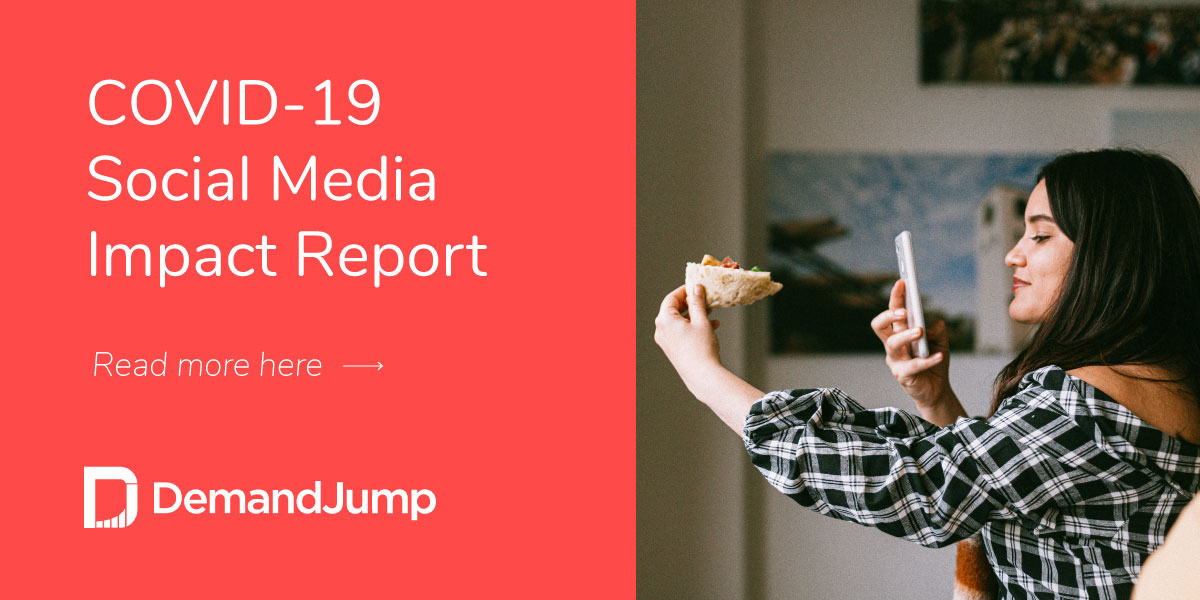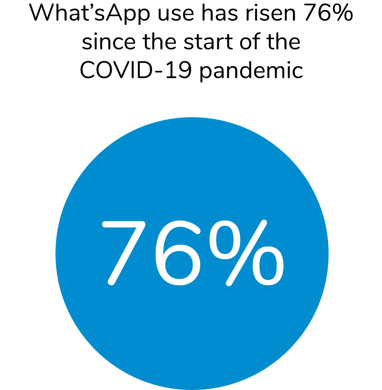COVID-19 Social Media Impact Report
April 28, 2020 •DJ Team

In March of 2020, The United States hunkered down to flatten the curve of COVID-19. This caused social media usage to increase by an average of 39% across the US, according to a global survey by Statista. Users surveyed in early March 2020 expected they would use YouTube and Facebook most often when eventually asked to shelter-in-place, so no one was surprised this happened.
But the question of how these users are behaving and what content they are looking for is essential to marketers who want to know how to drive website traffic and audience engagement. All these social media trends and products are now growing and developing in the strange new environment of the pandemic. Like everything else, “normal” social media is going to be different now.
Here’s the data that shows how user behaviors are changing, and informs other insights about the permanent long-term implications of the pandemic on social media and digital marketing.
(Click here to see what people are searching for around any topic or phrase right now.)
Time Spent on Social Media During Pandemic
Facebook and YouTube have already been the two fastest-growing social channels for several years, so it’s not surprising that they are growing even more during this time with people being cooped up in the house. Facebook-owned messenger What’sApp has secured its claim to a spot as third most popular platform and is growing fast. The messaging service has seen a progressive bump in users globally at different stages of the pandemic, according to TechCrunch. In nations just beginning to shelter, What’sApp usage rose by 20-40% in early stages, while in later-phase nations like China or Italy the app is being used 51% more. In Spain, use has risen by 76% and continues to climb, with no end in sight until the pandemic ends, too.

Zoom has also claimed a new significant portion of the market for social connection tools. Though it was not created as a social channel but a business tool, the app’s users rose from 10 million in November 2019 to 200 million in March 2020. The major growth led to some security issues for the app, which reflects some of the different demands and expectations this pandemic will define for social channels.
Social Media Behavior Analytics
How much time do we spend on social media in a day? Right now our answer is not really indicative of the normal truth. In a world of social isolation, the Internet has become our backyard, our concert venue, and our connection to the outside world. Social media has always been part of the desire for community and connection online, but the pandemic has users adopting more innovative features and platforms at a faster rate.
For instance, Twitch has become a massive hub for online concerts and live music events. Since February, the number of Facebook Live users has increased 50%. This means brands and businesses have a unique opportunity to feature video and live streaming in their own communications. Use data analytics tools for digital marketing to figure out the questions and concerns your audience is trying to answer on social media during this time. Then, get filming with your answers! This trend is catching on due to isolation but won’t necessarily go away when the threat of the disease has been controlled.
Another behavioral trend on the rise in social media is “shaming” that some experts believe isn’t all bad. In the past lots of online shaming or bullying was linked to opinion and personal morality, or considered a negative effect of spending too much time on social media. But the coronavirus pandemic has given a shared set of standards for acceptable behavior that seem to redefine online shaming for the better. Online social networks have become their own judge and jury for those who choose to break the law and put others at risk. Other trends in social shaming involve calling out celebrities and other tone-deaf posters who are complaining about their privileges during this time. Some outcry over social media trends has even led people to be criminally prosecuted, like attention attracted many national and international responses to the Tik-Tok COVID challenge. Even in a time of increased social media consumption, inauthentic or selfish content is more unpopular than ever.
COVID-19 Impact on Social Media Policies
While inauthentic content might be easy to spot, especially depending on your average phone screen time per day. But one of the biggest trends that will permanently affect social media after the pandemic is the rise and spread of totally inaccurate and dangerous content.
The FBI has issued advanced fraud warnings as COVID-19 treatment fraud and testing fraud schemes are devised by criminals. The FBI says to beware of any individuals selling test kits, supplies, or treatments. These schemes may begin to be shared or take root in social media. Charity scams and investment scams are also on the rise according to the Department of Justice. Social media channels already make it a high priority to screen and remove this kind of content.
But outright criminal fraud isn’t the only kind of harmful content. There’s also misinformation. A study conducted by Indiana University researchers after the 2016 presidential election documented elements like how bots share and promote stories in the seconds before they go viral. A mere 6% of bots spread 31% of the low-credibility content on the platform during the election and there’s certainly no reason to believe they have stopped.
Today, well-meaning individuals who want to share news, updates, and commentary about the COVID-19 pandemic are enabling bots to share misinformation more subtly and pervasively than ever. One Scientific American blogger shared their experience of receiving the screenshot of an email forward signed by a real-life Harvard researcher and doctor. Except the contents of the screenshot were actually fake.
Amid an environment of very emotional content, the true medical information that is valuable and accurate can be almost impossible to spot. But social media giant Facebook is especially under advanced scrutiny to step up their efforts to control misinformation.
Because people are working from home, this means that social media platforms are having to increasingly rely on AI for quality control and to monitor for misinformation. Facebook made international news when it flagged and removed links from legitimate sources like the BBC and other news outlets. The social media giant claimed the issue was with an automated system that blocked links from “abusive” websites, but experts published in Forbes claim the incident smacked of “machine learning left unattended.” More discourse and interest in the role of AI bots in social media may certainly be a result of the pandemic.
Facebook, Google, LinkedIn, Microsoft, Reddit, Twitter and YouTube issued a joint industry statement about their specific efforts to work together and combat misinformation about the virus. The question becomes how this commitment will translate to customer expectations about the control of misinformation in general.
Increase Website Traffic with Relevant Cross-Channel Content
As different platforms are subject to changing user expectations, it’s essential to understand exactly what your target customer is looking for and how they get to you. Marketers need to know what channels audiences trust, and what questions they ask to find companies like yours.
Providing these real-time, cross-channel insights is just one way DemandJump empowers digital marketers. Our platform offers actionable insights about consumer behavior. Multi channel attribution tools like ours help marketers understand what customers are doing at the most critical moments of a buying journey. From the content your audience desires to the strategies of competitors you’re up against, these insights are how to increase organic traffic through authentic content that resonates with audiences.
With consumer insights, DemandJump helps you see the customer’s buying journey through their eyes and understand where you fit in best. Register for a free account and see for yourself how we can help remove uncertainty from your marketing.
Featured Articles
Categories
- Attribution Tracking (13)
- Channel Optimization (11)
- Consumer Insights (68)
- Content Marketing (251)
- Data Science (8)
- Digital Marketing (6)
- Digital Transformation (26)
- Enterprise (10)
- Lead Generation (14)
- Market Intelligence (8)
- Marketing Analytics (39)
- Marketing Attribution (57)
- Marketing Management (153)
- Marketing Operations (86)
- Organic Search (222)
- Paid Search (52)
- Pillar-Based Marketing (63)
- Programmatic Advertising (9)
- SaaS Content (14)
- SaaS Marketing (29)
- Search Marketing (111)
- SEO Keyword Research (28)
- SEO Pillar (18)
- SEO Strategy (46)
- SMB (5)
- Website Content (12)


